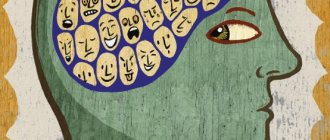Anxiety disorders in neurotic and neurosis-like conditions constitute a large, poorly differentiated layer in the structure of pathopsychological diagnoses. This confusing situation is associated with changing approaches to diagnosing and identifying individual diseases. In ICD-10 it is no longer possible to find such a diagnosis as anxiety neurosis; today it is considered not an independent disease, but a syndrome within the structure of generalized anxiety disorder and some other diseases. The point is controversial; in American psychiatric practice, anxiety-neurotic disorder is also included in panic disorder.
Anxiety-neurotic disorder is characterized by a feeling of constant anxiety, excitement, excessive timidity, hypochondriacal components are possible, when a person is constantly afraid of getting sick or looking for symptoms of certain diseases. Self-doubt, fears, suspiciousness - this is the core of the diagnosis, on which additional signs are layered.
Despite the discrepancies, the deviation has a lot of specific features; it can be isolated or occur in parallel with other mental problems. Diagnosis is difficult in terms of identifying the root cause, because it is quite possible that a complete symptomatic complex exists within the framework of neurosis-like schizophrenia, bipolar affective psychosis and other independent diagnoses. Treatment depends on understanding the essence of the changes.
Anxiety-neurotic disorder is treated primarily psychotherapeutically. Drug support is an additional measure. Despite the general safety of this disease, it is difficult to cure; correction of individual personality traits requires more than one year.
Concept
Anxiety neurosis is an emotional state characterized by fear of the unknown. Its cause cannot be precisely determined. Anxiety is accompanied by unpleasant physical symptoms.
Anxious fear differs from normal fear, which arises as a response to a real danger and lasts only during its existence. Usually natural fear has an irreplaceable protective value. It acts as an adaptation mechanism, encouraging the body to avoid or at least prepare for dangerous situations. If it occurs in inappropriate situations or is of excessive intensity and frequency, it is a disorder.
Types of alarm
Anxiety disorder, fear neurosis, is a chronic disease characterized by alternating phases of exacerbation and less intense symptoms. It usually first appears in adolescence; in adults, even without treatment, its intensity decreases.
With high intensity (especially panic attacks) due to hyperventilation (decrease in CO2 level), the threshold for vasodilation decreases, tingling occurs around the mouth, sometimes even leading to spasms and states of collapse with impaired consciousness.
Types of anxiety disorders:
- obsessive-compulsive disorder;
- social anxiety disorder;
- generalized anxiety disorder;
- post-traumatic stress disorder;
- agoraphobia;
- panic disorder;
- specific phobias.
Obsessive-compulsive disorder
OCD (obsessive-compulsive disorder) is a mental disorder whose main feature is repetitive obsessive actions and thoughts.
Obsessiveness is an urge, an obsessive thought, compulsion is an obsessive behavior.
A person with OCD suffers from unpleasant thoughts and finds relief from them by repeatedly performing certain activities:
- “I have to check if the door is locked 3 times because the number 2 is unlucky.”
- “Every morning I have to first step on the floor with my left foot, then my right foot, otherwise something will happen.”
- “I have to avoid tiles and leaves on the sidewalk.”
- “I wash and clean often because I’m afraid of bacteria.”
- “I need to constantly move things that have already been packed, such as clothes.”
- Other similar cases.
A person suffering from any of the above symptoms that make his life difficult (checking a locked door all night, etc.) needs to see a psychologist or psychotherapist. The disorder cannot be managed on your own, but it can be successfully treated with special therapy.
Social anxiety disorder (social phobia)
Social phobia (social fear, social anxiety, social anxiety disorder) is a disease that causes both physical and emotional problems in various social situations, such as communication, telephony, eating in public places, etc. People with social phobia recognize the irrationality of this anxiety, but are unable to cope with it. In addition, it is often deepened by suspiciousness and low self-esteem. This gradually leads to social isolation and chronic stress.
These people are often seen as introverts, and the phobia itself is seen as excessive anxiety for which there is no cure. Social phobia externally manifests itself on 2 levels: psychological or social and physical.
Manifestation of the social level – avoidance of social situations. These include:
- communication with people;
- New acquaintances;
- meeting with an authoritative person;
- expression of personal opinion in a group of people;
- making phone calls;
- Job;
- studies;
- eating and writing in front of others;
- lecturing;
- public speaking, etc.
The physical level can manifest itself:
- redness;
- lump in throat;
- trembling of hands;
- tachycardia or bradycardia;
- fainting.
These manifestations occur when people suffering from social phobia find themselves in situations that are unpleasant for them (for example, pressure from an employer, parents, others).
Generalized anxiety disorder
Generalized anxiety disorder (GAD) is a disorder characterized by excessive, uncontrollable fears and worries, usually related to everyday routine. The frequency, duration and intensity of manifestations are disproportionate to the source of anxiety. They affect a person's daily life.
The disorder affects women 2 times more often (mainly divorced, widowed), can occur at any age, but most often manifests itself in adolescence and is usually not diagnosed.
With this form of anxiety neurosis, the symptoms are represented by fear of problems at work, concerns about the financial situation, health, and family. But a person may worry about less serious things such as meetings, keeping the workplace or home environment clean. A common cause of neurosis is a stressful or traumatic event. The disorder usually begins between the ages of 16 and 18 and can last a lifetime (intensity varies).
The patient may become dependent on benzodiazepines or alcohol. Cases of dependence on Zolpidem have been described.
Post-traumatic stress disorder
Post-traumatic stress disorder (PTSD), sometimes also post-traumatic stress syndrome (PTSS) - F43 in the ICD - occurs as a reaction to a traumatic event. The person constantly experiences the event in thoughts, dreams and imagination, and avoids places and situations associated with the trauma.
PTSD is defined as a mental disorder that occurs as a result of sudden events that threaten life or personal integrity.
A terrible event can be experienced directly by the patient himself, his loved one (relative, friend), or he can only be present as a witness. Today, PTSD is viewed as a condition in which the integration of a traumatic event into daily routine is impaired.
The disorder often manifests itself with signs such as:
- sleep disorders;
- impaired concentration;
- memory impairment;
- fear as a reaction to an irritant.
Along with PTSD, the following may also occur:
- depression;
- generalized anxiety disorder;
- OCD;
- agoraphobia;
- depersonalization;
- various dependencies.
There is an acute stress response (symptoms lasting less than 3 months) and a chronic form of PTSD (symptoms lasting more than 3 months).
Causes of PTSD are situations that threaten the person himself or his loved ones:
- war;
- flood;
- fire;
- severe injury;
- road accident;
- cruel treatment;
- rape;
- kidnapping;
- life-threatening illness.
Risk factors also include changes in interpersonal relationships, social roles (job loss, partner's infidelity, divorce).
Agoraphobia
Agoraphobia is generally mistaken for a fear of open spaces. In fact, it is rather a fear of public space, places where help will not be available. These fears can make a person afraid to leave the house. At the same time, he can receive visitors and work without showing any disorder, provided he stays in a “safe zone.”
People suffering from agoraphobia experience severe panic attacks when they are insufficiently protected. An exacerbation of neurosis is a period during which a person can close himself in the house, in a room, or even not get out of bed until the irritated nervous system calms down and adrenaline levels return to normal.
People suffering from this disorder are often hypersensitive to physical reactions, subconsciously reacting inappropriately to normal, ordinary situations. For example, an agoraphobe's attempt to climb stairs may be interpreted as causing a panic attack because it causes the heart rate and breathing to increase.
Agoraphobia usually appears after the age of 30. The disorder rarely occurs in childhood or after age 45. Its course is chronic with variable intensity. You can only deal with the problem with the help of a specialist.
Panic disorder
This is a mental disorder characterized by repeated attacks of intense fear and internal discomfort that occur suddenly for no apparent reason. Within a few minutes, manifestations reach a maximum, usually lasting several minutes. These episodes are called panic attacks.
With a moderate disorder, the number of attacks is about 4 within 1 month. In severe form, there are more than 4 attacks within 1 week.
In recent years, panic disorder has come to the forefront among anxiety neuroses. People with this condition often experience excessive stress, but the vast majority live normal personal and professional lives.
Specific phobias
Specific phobia is a general term describing a group of anxiety disorders. It manifests itself as unreasonable or meaningless fear associated with an object or situation. As a result, the person suffering from a phobia avoids these objects or situations.
The trigger for fear or anxiety that leads to a panic attack may be encountering or anticipating an encounter with a “terrible” object or situation (called anticipatory anxiety).
In adults, the phobia is usually conscious. However, it is difficult for a person to control anxiety and avoidance behavior, although this can have a significant impact on daily life and physical health (especially in the case of achmophobia). The onset of the phobia usually occurs in childhood (the disorder often subsides spontaneously in adulthood). The cause may be a congenital disorder (in 30-40% of cases) or a traumatic experience. Sometimes a risk factor is long-term depression (for example, depression during pregnancy or after childbirth).
Relatively often, a person has to get rid of a phobia with the help of a psychotherapist.
Types of phobias:
- fear of animals (eg arachnophobia - fear of spiders);
- phobias associated with the natural environment (acrophobia - fear of heights, keraunophobia - fear of thunderstorms, lightning);
- situational type phobia (claustrophobia - fear of enclosed spaces, hagiophobia - fear of crossing the road);
- injection/injury phobia (ahmophobia - fear of needles and sharp-pointed objects);
- hemophobia – fear of blood (unpleasant during menstruation, typical of expressive PMS);
- other.
Symptoms of the disorder
Symptoms of pathology are divided into psychological and physiological, some of them are visible to the naked eye, others can only be identified by a doctor.
Psychological symptoms include:
- sudden anxiety;
- worry for no reason;
- extreme irritability, tears for no reason;
- lethargy and apathy;
- indifference to what is happening around;
- difficulty concentrating;
- difficulties in adapting to new circumstances, in coordination in space;
- fear of open areas - agoraphobia;
- constant tension, the person does not relax;
- obsessive thoughts with detailed depictions of terrible events;
- reluctance to communicate with other people;
- sudden mood swings that lead to a constantly negative perception of reality - depression;
- painful reaction to noise, bright light, darkness.
Physiological symptoms are:
- sleep disorders - insomnia alternating with daytime sleepiness;
- problems with the cardiovascular system - pain, tachycardia, heart rhythm disturbances;
- difficulty breathing, shortness of breath;
- interruptions in the functioning of the digestive system;
- headaches, dizziness;
- lack of appetite or nausea, vomiting;
- weakness throughout the body or constant tension in the muscles;
- blood pressure surges;
- tremor throughout the body;
- excessive sweat production;
- pre-fainting states.
Symptoms can appear individually or in combination. Often a person suffering from them cannot name the exact cause of his fears.
Anxiety neurosis is dangerous because it can easily turn into hypochondria, schizophrenia, depressive disorder, psychosis, and hysteria. The difference between neurosis and psychosis is that during psychosis a person’s appearance changes significantly, he ceases to control his actions, throws hysterics or does not show any interest in everything that is happening, the reaction to stimuli from the outside world is often inhibited.
Another important feature: a mentally ill person is convinced that everything is fine with him; a person suffering from anxiety neurosis realizes that he needs medical help.
You cannot mistake simple excitement for a neurotic state. But if it becomes permanent, you should pay attention to it. This can be anxiety syndrome if a person is afraid of the same things that do not pose a real danger to him.
As an example, we can cite a situation where a child was severely scolded by his parents for being late. Growing up, he experiences anxiety at any delay on his part, terribly afraid of being late. This installation is already included in it. You can only get rid of it by seriously engaging in treatment.
Common reasons
There are many theories explaining why anxiety neuroses occur. It was originally thought that anxiety had only a psychological basis. But today, determining the cause of anxiety is difficult. Genetics, education, biological or existential factors play a role in their development. Their composition determines the severity and type of anxiety disorder.
Conflicts from early childhood in families with a strict and restrictive upbringing are also considered to be a cause of anxiety. Stressful situations in adulthood reveal these conflicts, causing fear and anxiety.
Frequent stressful experiences and poor family background cause a weakening of the child’s personality and the subsequent development of anxiety neurosis.
Anxiety disorders can also be caused by an insufficiently strong emotional attachment to parents in childhood, when temporary separation (upon entering kindergarten, parental divorce...) leads to the development of neurasthenia and anxiety.
The disorder may be caused by misinterpretation of thoughts and body sensations. The general reaction of the body is perceived as a symptom of a threat, causing the development of fear and anxiety.
Existential theory says that a suspicious person is prone to developing neurosis when aware of mortality. He defends himself by searching for the meaning of life and filling it. The genetic origin of anxiety neurosis is proven by the higher frequency of its cases in individuals who have relatives suffering from this disorder.
Why does fear neurosis occur?
Fear neurosis has many “fathers”. But most often the disorder appears due to:
- psychological trauma (dismissal, divorce). A person begins to lose ground under his feet, the future becomes foggy. This is what gives rise to neurosis;
- severe stressful situations (passing an exam, moving to another city, pregnancy). Too sudden changes in life instill uncertainty and cause fear;
- "psychological heredity". If a child grows up in a “neurotic” family, where parents are constantly worried, then he gradually becomes anxious himself.
Fear neurosis can be caused not only by mental, but also by physiological problems. It is provoked by:
- pathologically active thyroid gland;
- hormonal imbalances caused by various diseases, menopause;
- genetic predisposition. According to statistics, people whose close relatives are susceptible to fear neurosis suffer from this disorder several times more often than others.
Diagnostics
People with serious anxiety neurosis are frequent visitors to clinics and doctors' offices. Their problem is often hidden behind vague physical manifestations or various diseases.
A common feature of neuroses is an unjustified fear of some part of an ordinary day, which can take almost any form. This problem is common to many types of anxiety neuroses, and other conditions must be monitored to determine a specific disorder. Comparison of specific criteria is important for an accurate diagnosis.
Treatment
Treatment of fear and anxiety neurosis is based on a combination of psychotherapy and pharmacological drugs.
In psychological therapy, the cognitive-behavioral technique is most often used, which involves changing behavior through a change in consciousness. The goal of treatment is to change a person’s view of the world by changing his thinking, opinions, and views. At the same time, she strives to mitigate the negative psychological and physical (vegetative) manifestations of anxiety. In addition, attempts are made to reduce the avoidance behavior that a person uses to avoid anxiety in a particular situation.
Pharmacological treatment of fear neurosis is carried out with the help of drugs - anxiolytics. As a rule, therapy begins with the use of drugs from the group of benzodiazepines. They are suitable for the acute course of the disease, because... able to quickly overcome anxiety. But after stopping treatment, symptoms return. Therefore, it is advisable to use antidepressants simultaneously, even in the absence of signs of depression. The effectiveness of these drugs is comparable to benzodiazepines, but they have a slower onset of action (up to 5 weeks), fewer unwanted symptoms and lack of dependence. Once the antidepressant begins to take effect, benzodiazepines should be stopped slowly.
As an additional therapy, you can use traditional methods - herbs (in particular, lemon balm and other soothing plants).
Benzodiazepines are not suitable for long-term treatment because... After about 4 months, the body develops tolerance to them, which reduces their effect. Longer use may impair memory, spatial awareness, learning and emotional expression. Mild motor impairment may occur. In addition, these drugs are addictive.
What is anxiety neurosis?
Anxiety neurosis is a disorder that occurs due to prolonged anxiety, prolonged chronic stressful situations, or a single experience of severe stress. In the initial stages, the patient often does not realize that there is a problem, but later, when the symptoms become more pronounced, he often consults a doctor on his own.
Due to pathology, the quality of life deteriorates:
- Performance decreases, the number of contacts with other people decreases;
- It becomes more difficult to focus on any tasks or matters.
Often the cause of the condition is first attributed to cardiac problems. The patient may first note vegetative manifestations, not paying attention to psychological ones.
Prevention
A natural way to prevent attacks and protect against anxiety is to avoid situations that cause anxiety. But evasive behavior perpetuates the problem. It is much more effective to face the trigger head on. Gradually expose yourself to “risky” situations and things. Make brief eye contact with your neighbor or colleague, prepare a short lecture, presentation to work colleagues, walk around a crowded square.
Such psychological “exercises” will teach you how to manage threatening situations and lead to a gradual reduction in anxiety. Cognitive behavioral psychotherapy is based on this principle.










